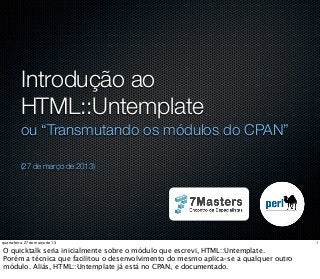
Introdução ao HTML::Untemplate, ou “Transmutando os módulos do CPAN”
- 1. Introdução ao HTML::Untemplate ou “Transmutando os módulos do CPAN” (27 de março de 2013) quarta-feira, 27 de março de 13 1 O quicktalk seria inicialmente sobre o módulo que escrevi, HTML::Untemplate. Porém a técnica que facilitou o desenvolvimento do mesmo aplica-se a qualquer outro módulo. Aliás, HTML::Untemplate já está no CPAN, e documentado.
- 2. xpathify /html/@lang pt-br //meta[@http-equiv='Content-Type'][1]/@content text/html; charset=UTF-8 /html/head[1]/title[1]/text() Perl | 7Masters //link[@rel='shortcut icon'][1]/@href http://setemasters.imasters.com.br/wp-content/themes/setemasters/assets/images/favicon.ico //link[@rel='shortcut icon'][1]/@type image/x-icon //meta[@name='robots'][1]/@content noindex,nofollow //link[@rel='stylesheet'][1]/@href http://setemasters.imasters.com.br/wp-content/themes/setemasters/style.css?ver=1363802105 //link[@rel='stylesheet'][1]/@media all //link[@rel='stylesheet'][1]/@type text/css /html/head[1]/script[1]/@src http://setemasters.imasters.com.br/wp-includes/js/jquery/jquery.js?ver=1.8.3 /html/head[1]/script[1]/@type text/javascript quarta-feira, 27 de março de 13 2 O módulo em questão “reinventa” a apresentação de um documento HTML, transformando a árvore DOM em pares key/value, aonde keys são strings XPath que identificam a localização do conteúdo (em values).
- 3. untemplate /html/head[1]/title[1]/text() PHP | 7Masters Perl | 7Masters .Net | 7Masters Java | 7Masters //img[@class='attachment-edition-featured wp-post-image'][1]/@src http://setemasters.imasters.com.br/wp-content/uploads/sites/3/2013/02/php-160x1601.png http://setemasters.imasters.com.br/wp-content/uploads/sites/3/2013/02/perl-160x160.png http://setemasters.imasters.com.br/wp-content/uploads/sites/3/2013/02/dotnet-160x160.png http://setemasters.imasters.com.br/wp-content/uploads/sites/3/2013/02/java-160x160.png //img[@class='attachment-edition-featured wp-post-image'][1]/@alt php-160x160 perl-160x160 dotnet-160x160 java-160x160 //h2[@class='featured-edition-title'][1]/strong[1]/text() PHP Perl .Net Java //span[@class='release-date'][1]/text() 30 de janeiro de 2013 A Partir das 19h00 27 de março de 2013 30 de outubro de 2012 27 de novembro de 2012 quarta-feira, 27 de março de 13 3 Essa representação facilita “diff” de dois (ou mais) páginas em HTML (output de /usr/bin/diff geralmente é uma bagunça para HTML gerado a partir de um template).
- 4. O primeiro passo: um parser de HTML http://stackoverflow.com/questions/1732348/regex-match-open-tags-except-xhtml-self-contained-tags/1732454#1732454 quarta-feira, 27 de março de 13 4 Parsers parecem simples. De fato, 80% das funcionalidades de um parser são implementados em 20% do tempo de desenvolvimento. Fazer um parser de HTML completo usando regexp está na contramão do sucesso (todavia, pequenos regexp pontuais - OK).
- 5. Reutilizando HTML::Tree <html lang="en" xml:lang="en" xmlns="http://www.w3.org/1999/xhtml"> @0 <head> @0.0 <title> @0.0.0 "The Perl Programming Language - www.perl.org" <meta content="text/html;charset=utf-8" http-equiv="Content-Type" /> @0.0.1 <link href="http://st.pimg.net/perlweb/favicon.v249dfa7.ico" rel="shortcut icon" /> @0.0.2 <link href="http://st.pimg.net/perlweb/css/leostyle.vf79cee0.css" rel="stylesheet" type="text/css" /> @0.0.3 <link href="http://st.pimg.net/perlweb/css/www.ve1fe6bb.css" rel="stylesheet" type="text/css" /> @0.0.4 <meta content="The Perl Programming Language at Perl.org. Links and other helpful resources for new and experienced Perl programmers." name="description" /> @0.0.5 <script charset="utf-8" src="http://ajax.googleapis.com/ajax/libs/jquery/1.3.2/jquery.min.js" type="text/javascript"> @0.0.6 <script charset="utf-8" src="http://st.pimg.net/perlweb/js/jquery.corner.v84b7681.js" type="text/javascript"> @0.0.7 <script charset="utf-8" src="http://st.pimg.net/perlweb/js/leo.v9872b9c.js" type="text/javascript"> @0.0.8 <body class="section_home"> @0.1 <div id="header_holder"> @0.1.0 <div class="sub_holder"> @0.1.0.0 <div id="page_image"> @0.1.0.0.0 <h1> @0.1.0.0.1 " The Perl Programming Language " <div id="logo_holder"> @0.1.0.0.2 <a href="/"> @0.1.0.0.2.0 <img align="right" alt="Perl, modern programming" height="65" id="logo" src="http://st.pimg.net/perlweb/ images/camel_head.v25e738a.png" /> @0.1.0.0.2.0.0 " " <span> @0.1.0.0.2.2 "www.perl.org" <div id="nav"> @0.1.1 quarta-feira, 27 de março de 13 5 HTML::Tree existe e é ativamente mantido desde 1998. Extremamente robusto, tolera bem input “disforme”. Implementa o método address() que aponta a localização do nó na árvore DOM. Bom ponto de partida!
- 6. SUPER:: power 1 package HTML::Linear; 2 use base 'HTML::TreeBuilder'; 3 use strict; 4 use warnings 'all'; 5 6 sub eof { 7 my ($self, @args) = @_; 8 my $retval = $self->SUPER::eof(@args); 9 10 $self->deparse($self, []); 11 ...; 12 13 return $retval; 14 } quarta-feira, 27 de março de 13 6 Modelo de herança “tradicional” presente em qualquer linguagem que implementa o paradigma OOP. No caso do Perl, SUPER:: “cru” muda o foco de “o que fazer” para “como fazer” (too many code!).
- 7. Aspect-Oriented Programming através de Moose Method Modifiers 1 package HTML::Linear; 2 use Moo; 3 extends 'HTML::TreeBuilder'; 4 5 after eof => sub { 6 my ($self) = @_; 7 8 $self->deparse($self, []); 9 ...; 10 }; quarta-feira, 27 de março de 13 7 AOP existe em Java. No Perl, o maior representante é o Moose, que introduziu os “method modifiers”. Menos código, mais abstração. Mais foco em “o que fazer” do que “como fazer”.
- 8. Moose::Manual::MethodModifiers para mais detalhes. 1 package Example; 2 3 use Moo; # Moose, Mouse? 4 5 sub foo { 6 print " foon"; 7 } 8 9 before foo => sub { print "about to call foon" }; 10 after foo => sub { print "just called foon" }; 11 12 around foo => sub { 13 my $orig = shift; 14 my $self = shift; 15 16 print " I'm around foon"; 17 18 $orig->($self => @_); 19 20 print " I'm still around foon"; 21 }; quarta-feira, 27 de março de 13 8 “before” altera os parâmetros da função. “after” altera o valor do ‘return’. “around” seria o equivalente ao SUPER:: que funciona através de um callback.
- 9. Moose, Mouse, Any::Moose, Moo... Obs.: Moo dispensa ::NonMoose! CPAN: all your method are belong to us! quarta-feira, 27 de março de 13 9 Alteração dos métodos é possível, nativamente, em qualquer módulo do CPAN que utilize Moose ou Mouse. Outros módulos podem ser assimilados via Mo[ou]seX::NonMoose. Já o Moo é capaz de aplicar after/before/around sem nenhum “artefato externo”; inclusive nos módulos do tipo XS!
- 10. Obrigado! Stanislaw Pusep <stas@sysd.org> blogs.perl.org/users/stas coderwall.com/creaktive github.com/creaktive twitter.com/creaktive quarta-feira, 27 de março de 13 10
